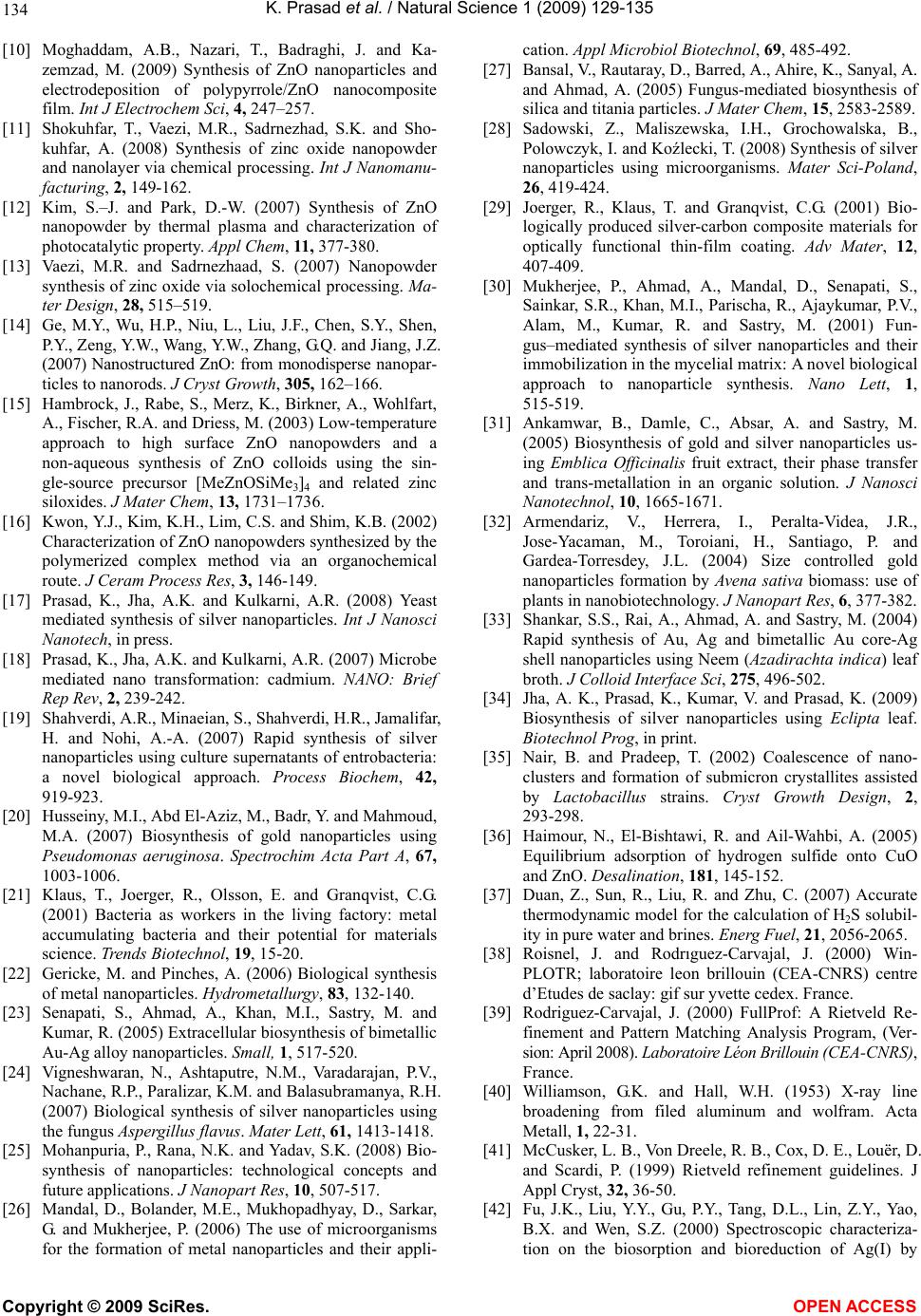
K. Prasad et al. / Natural Science 1 (2009) 129-135
Copyright © 2009 SciRes. OPEN ACCESS
134
[10] Moghaddam, A.B., Nazari, T., Badraghi, J. and Ka-
zemzad, M. (2009) Synthesis of ZnO nanoparticles and
electrodeposition of polypyrrole/ZnO nanocomposite
film. Int J Electrochem Sci, 4, 247–257.
[11] Shokuhfar, T., Vaezi, M.R., Sadrnezhad, S.K. and Sho-
kuhfar, A. (2008) Synthesis of zinc oxide nanopowder
and nanolayer via chemical processing. Int J Nanomanu-
facturing, 2, 149-162.
[12] Kim, S.–J. and Park, D.-W. (2007) Synthesis of ZnO
nanopowder by thermal plasma and characterization of
photocatalytic property. Appl Chem, 11, 377-380.
[13] Vaezi, M.R. and Sadrnezhaad, S. (2007) Nanopowder
synthesis of zinc oxide via solochemical processing. Ma-
ter Design, 28, 515–519.
[14] Ge, M.Y., Wu, H.P., Niu, L., Liu, J.F., Chen, S.Y., Shen,
P.Y., Zeng, Y.W., Wang, Y.W., Zhang, G.Q. and Jiang, J.Z.
(2007) Nanostructured ZnO: from monodisperse nanopar-
ticles to nanorods. J Cryst Growth, 305, 162–166.
[15] Hambrock, J., Rabe, S., Merz, K., Birkner, A., Wohlfart,
A., Fischer, R.A. and Driess, M. (2003) Low-temperature
approach to high surface ZnO nanopowders and a
non-aqueous synthesis of ZnO colloids using the sin-
gle-source precursor [MeZnOSiMe3]4 and related zinc
siloxides. J Mater Chem, 13, 1731–1736.
[16] Kwon, Y.J., Kim, K.H., Lim, C.S. and Shim, K.B. (2002)
Characterization of ZnO nanopowders synthesized by the
polymerized complex method via an organochemical
route. J Ceram Process Res, 3, 146-149.
[17] Prasad, K., Jha, A.K. and Kulkarni, A.R. (2008) Yeast
mediated synthesis of silver nanoparticles. Int J Nanosci
Nanotech, in press.
[18] Prasad, K., Jha, A.K. and Kulkarni, A.R. (2007) Microbe
mediated nano transformation: cadmium. NANO: Brief
Rep Rev, 2, 239-242.
[19] Shahverdi, A.R., Minaeian, S., Shahverdi, H.R., Jamalifar,
H. and Nohi, A.-A. (2007) Rapid synthesis of silver
nanoparticles using culture supernatants of entrobacteria:
a novel biological approach. Process Biochem, 42,
919-923.
[20] Husseiny, M.I., Abd El-Aziz, M., Badr, Y. and Mahmoud,
M.A. (2007) Biosynthesis of gold nanoparticles using
Pseudomonas aeruginosa. Spectrochim Acta Part A, 67,
1003-1006.
[21] Klaus, T., Joerger, R., Olsson, E. and Granqvist, C.G.
(2001) Bacteria as workers in the living factory: metal
accumulating bacteria and their potential for materials
science. Trends Biotechnol, 19, 15-20.
[22] Gericke, M. and Pinches, A. (2006) Biological synthesis
of metal nanoparticles. Hydrometallurgy, 83, 132-140.
[23] Senapati, S., Ahmad, A., Khan, M.I., Sastry, M. and
Kumar, R. (2005) Extracellular biosynthesis of bimetallic
Au-Ag alloy nanoparticles. Small, 1, 517-520.
[24] Vigneshwaran, N., Ashtaputre, N.M., Varadarajan, P.V.,
Nachane, R.P., Paralizar, K.M. and Balasubramanya, R.H.
(2007) Biological synthesis of silver nanoparticles using
the fungus Aspergillus flavus. Mater Lett, 61, 1413-1418.
[25] Mohanpuria, P., Rana, N.K. and Yadav, S.K. (2008) Bio-
synthesis of nanoparticles: technological concepts and
future applications. J Nanopart Res, 10, 507-517.
[26] Mandal, D., Bolander, M.E., Mukhopadhyay, D., Sarkar,
G. and Mukherjee, P. (2006) The use of microorganisms
for the formation of metal nanoparticles and their appli-
cation. Appl Microbiol Biotechnol, 69, 485-492.
[27] Bansal, V., Rautaray, D., Barred, A., Ahire, K., Sanyal, A.
and Ahmad, A. (2005) Fungus-mediated biosynthesis of
silica and titania particles. J Mater Chem, 15, 2583-2589.
[28] Sadowski, Z., Maliszewska, I.H., Grochowalska, B.,
Polowczyk, I. and Koźlecki, T. (2008) Synthesis of silver
nanoparticles using microorganisms. Mater Sci-Poland,
26, 419-424.
[29] Joerger, R., Klaus, T. and Granqvist, C.G. (2001) Bio-
logically produced silver-carbon composite materials for
optically functional thin-film coating. Adv Mater, 12,
407-409.
[30] Mukherjee, P., Ahmad, A., Mandal, D., Senapati, S.,
Sainkar, S.R., Khan, M.I., Parischa, R., Ajaykumar, P.V.,
Alam, M., Kumar, R. and Sastry, M. (2001) Fun-
gus–mediated synthesis of silver nanoparticles and their
immobilization in the mycelial matrix: A novel biological
approach to nanoparticle synthesis. Nano Lett, 1,
515-519.
[31] Ankamwar, B., Damle, C., Absar, A. and Sastry, M.
(2005) Biosynthesis of gold and silver nanoparticles us-
ing Emblica Officinalis fruit extract, their phase transfer
and trans-metallation in an organic solution. J Nanosci
Nanotechnol, 10, 1665-1671.
[32] Armendariz, V., Herrera, I., Peralta-Videa, J.R.,
Jose-Yacaman, M., Toroiani, H., Santiago, P. and
Gardea-Torresdey, J.L. (2004) Size controlled gold
nanoparticles formation by Avena sativa biomass: use of
plants in nanobiotechnology. J Nanopart Res, 6, 377-382.
[33] Shankar, S.S., Rai, A., Ahmad, A. and Sastry, M. (2004)
Rapid synthesis of Au, Ag and bimetallic Au core-Ag
shell nanoparticles using Neem (Azadirachta indica) leaf
broth. J Colloid Interface Sci, 275, 496-502.
[34] Jha, A. K., Prasad, K., Kumar, V. and Prasad, K. (2009)
Biosynthesis of silver nanoparticles using Eclipta leaf.
Biotechnol Prog, in print.
[35] Nair, B. and Pradeep, T. (2002) Coalescence of nano-
clusters and formation of submicron crystallites assisted
by Lactobacillus strains. Cryst Growth Design, 2,
293-298.
[36] Haimour, N., El-Bishtawi, R. and Ail-Wahbi, A. (2005)
Equilibrium adsorption of hydrogen sulfide onto CuO
and ZnO. Desalination, 181, 145-152.
[37] Duan, Z., Sun, R., Liu, R. and Zhu, C. (2007) Accurate
thermodynamic model for the calculation of H2S solubil-
ity in pure water and brines. Energ Fuel, 21, 2056-2065.
[38] Roisnel, J. and Rodrıguez-Carvajal, J. (2000) Win-
PLOTR; laboratoire leon brillouin (CEA-CNRS) centre
d’Etudes de saclay: gif sur yvette cedex. France.
[39] Rodriguez-Carvajal, J. (2000) FullProf: A Rietveld Re-
finement and Pattern Matching Analysis Program, (Ver-
sion: April 2008). Laboratoire Léon Brillouin (CEA-CNRS),
France.
[40] Williamson, G.K. and Hall, W.H. (1953) X-ray line
broadening from filed aluminum and wolfram. Acta
Metall, 1, 22-31.
[41] McCusker, L. B., Von Dreele, R. B., Cox, D. E., Louër, D.
and Scardi, P. (1999) Rietveld refinement guidelines. J
Appl Cryst, 32, 36-50.
[42] Fu, J.K., Liu, Y.Y., Gu, P.Y., Tang, D.L., Lin, Z.Y., Yao,
B.X. and Wen, S.Z. (2000) Spectroscopic characteriza-
tion on the biosorption and bioreduction of Ag(I) by